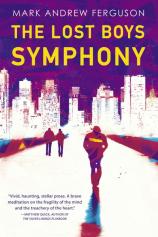The Lost Boys Symphony
Review
The Lost Boys Symphony
Mark Andrew Ferguson’s debut novel, THE LOST BOYS SYMPHONY, is not your typical time-travel story, though time becomes slippery and unreliable with his inventive pen. Taking the usual understanding of literary time travel and adding a bit of Vonnegut’s idea of being “unstuck in time,” and complicating things with the idea that the characters may be just imagining or hallucinating most of the action, Ferguson’s story is complex, layered and compelling.
Nineteen-year-old Henry, a talented musician and student at Rutgers University, is happily living with his best friend, Gabe, and deeply in love with his girlfriend, Val. For years, the three have formed a balanced triangle of affection and support. When Val, feeling like she needs to explore the world outside of New Jersey, breaks up with Henry and transfers to NYU, Henry’s world starts to come apart at the seams. Gabe notices that Henry’s behavior moves rapidly from depressed to odd to frightening. Henry, for his part, is terrified of the man (perhaps his older self) he meets at school and is drawn farther and farther from reality by almost constant visual and auditory hallucinations, including a “bright green spastic low vibration” that pulls him to the George Washington Bridge.
"Val and Gabe are two relatable and likable characters, and they take the book from fantasy to coming-of-age: an interesting and generally successful mix here.... THE LOST BOYS SYMPHONY is not an easy read, but it’s a good one."
From there, Henry finds himself in the company of 80 and 41, future versions of himself. Eighty and 41 years old respectively, they become unrooted in their own time and have come back to affect their own past (and 19-year-old Henry’s future). This Sisyphean task, however, results in an endless variety of possible pasts and futures and an overlapping of time as different Henrys come together and often struggle against each other, for control of their shared but different life.
Meanwhile, young Gabe and Val come together and fall in love in 19-year-old Henry’s absence. Their guilt, along with the interference of various Henrys, pushes them apart only to bring them together again as the reality of Henry’s life changes with each action of future Henry. Marriages, pregnancies, generations and careers all come into existence only to disappear while lingering in Henry’s sad and bitter memories. Henry, Gabe and Val all believe that Henry suffers from a debilitating mental illness, and thus readers and characters remain unsure how much of this tale is a product of Henry’s unwell mind or how much of the unwell mind is a product of the time travel.
The overlap of Henrys sometimes renders THE LOST BOYS SYMPHONY confusing or muddled. Ferguson’s story slides around in time, and that time itself is inconsistent as it is constantly being altered by Henry. Though it seems at times that Henry is a schizophrenic, his illness is never clearly defined, so readers must grapple with his reliability in understanding the events taking place. Yet Ferguson gives Gabe and Val a few key experiences that call into question mental illness as the cause of Henry’s disappearance. Because readers have the perspectives of both Gabe and Val, in addition to Henry, they can, even in the midst of the Henry chaos, maintain equilibrium. Val and Gabe are two relatable and likable characters, and they take the book from fantasy to coming-of-age: an interesting and generally successful mix here.
There is a lot of strangeness in the novel, but it’s coupled with an honest look at love, friendship, loss and regret. THE LOST BOYS SYMPHONY is not an easy read, but it’s a good one.
Reviewed by Sarah Rachel Egelman on March 26, 2015
The Lost Boys Symphony
- Publication Date: March 8, 2016
- Genres: Fiction
- Paperback: 352 pages
- Publisher: Back Bay Books
- ISBN-10: 0316324035
- ISBN-13: 9780316324038





